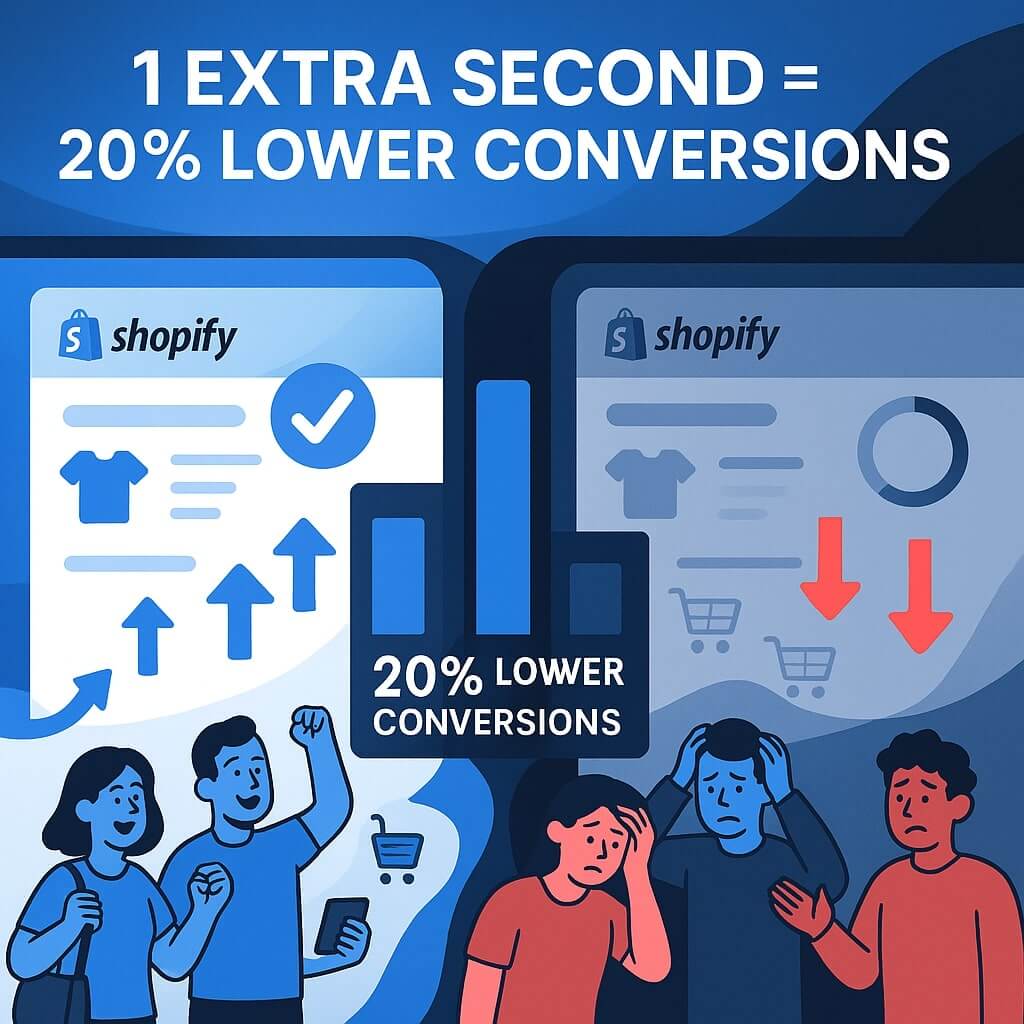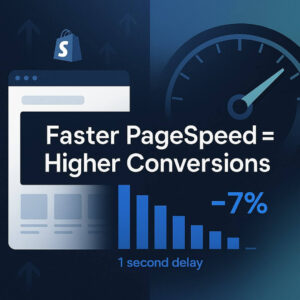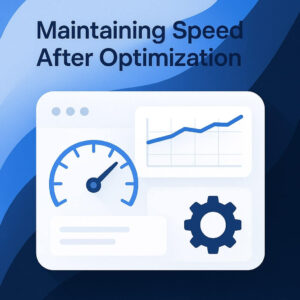The Ultimate Guide to Improving Shopify Store Speed and Conversion Rates in 2025
Estimated reading time: 8 minutes
- Speed matters: Even a 0.1 second improvement can significantly boost conversions.
- Technical foundations: Front-end and back-end optimizations are both critical.
- User experience: Fast websites build trust and make customers more likely to return.
- Active monitoring: Regular audits help catch new speed issues early.
- Advanced tactics: Leverage Shopify’s tools and run tests for continuous improvement.
Table of Contents
- Why Shopify Store Speed Is Critical for Conversion Rates
- How Store Speed Directly Affects Revenue and Customer Experience
- The Technical Foundations of Faster Shopify Stores
- Essential Strategies to Increase Shopify Store Conversion Rates
- Common Shopify Speed Roadblocks—and How to Fix Them
- Choosing a High-Performance Shopify Theme
- Shopify Speed & Conversion: Advanced Tactics and Ongoing Monitoring
- FAQs About Shopify Speed and Conversion Optimization
- Conclusion
Why Shopify Store Speed Is Critical for Conversion Rates
Page load time isn’t just a technical concern—it’s a cornerstone of great user experience and a major conversion driver. According to Google[1], as page load time goes from 1 second to 3 seconds, the probability of a bounce increases by 32%. On mobile, this number can be even higher. For e-commerce, the implications are costly: research by Deloitte found that even a 0.1 second improvement in site speed can increase retail conversions by 8%.
Why does speed matter so much on Shopify? Slow-loading stores frustrate shoppers, diminish trust, and send buyers to competitors. They also impact your search engine rankings, as Google considers speed a ranking factor, meaning your organic visibility—and therefore traffic—can suffer. For Shopify stores, where most themes and apps add extra code, keeping your storefront lightweight and speedy is a daily challenge that pays off in real money.
- Increased Abandonment: About 70% of online carts are abandoned—slow speed is a top reason.
- SEO Impact: Speed influences both crawlability and user signals, affecting where you rank.
- First Impressions: 79% of shoppers who experience poor performance are less likely to buy again.
Speed impacts every stage of your conversion funnel, from initial landing to checkout. That’s why optimizing Shopify store speed isn’t just IT housekeeping—it’s mission critical for e-commerce growth.
How Store Speed Directly Affects Revenue and Customer Experience
Speed and conversions are directly connected—every millisecond affects how users perceive your brand and whether they buy. Multiple studies, including research by Akamai, confirm that a 100-millisecond delay in load time can decrease conversion rates by 7%. In the ultra-competitive Shopify ecosystem, this means thousands of dollars in lost revenue per month for even moderately sized stores.
But it’s not just about lost conversions; speed is tied to total customer experience. Consider the following:
- Trust and Credibility: Fast-loading sites feel more professional, trustworthy, and secure to shoppers.
- Retention and Repeat Buyers: A seamless experience makes customers much more likely to return for future purchases.
- Mobile Performance: As of 2025, mobile traffic dominates e-commerce. Slow speeds on mobile devices translate to missed opportunities—especially since mobile users are even less tolerant of lag.
Case Study Example: One Shopify merchant trimmed homepage load times by 1.5 seconds by reducing app usage and switching to a performance-optimized theme. Within a month, bounce rates dropped by 19%, and conversion rates improved by 12%, resulting in a substantial lift in monthly revenue.
Ultimately, optimizing Shopify store speed isn’t just about technical bragging rights—it’s one of the most impactful levers for increasing revenue and delivering a positive shopping experience.
The Technical Foundations of Faster Shopify Stores
Speed optimization on Shopify involves both front-end and back-end factors. The platform’s hosted environment handles core infrastructure, but store owners must manage what they can control: theme code, asset sizes, third-party apps, images, and custom scripts.
- Theme Efficiency: Lightweight themes with minimal bloat are foundational. Themes with hand-written, well-structured code load faster and are easier to maintain.
- Image Optimization: Images are the #1 culprit for slow load times. Use compressed images (e.g., WebP format), implement lazy loading, and leverage Shopify’s built-in CDN for asset delivery.
- App Management: Some apps inject dozens of scripts and styles into your storefront. Reducing unnecessary apps—or switching to native theme functionality—significantly improves speed.
- Script & Code Loading: Defer non-critical JavaScript, minimize CSS and JS files, and ensure code is loaded asynchronously to prevent render-blocking.
- Shopify Liquid Best Practices: Ensure your theme makes efficient use of Shopify’s Liquid templating, only loading code and assets where needed (avoid excessive snippets, sections, and app blocks).
Modern speed testing tools like Google PageSpeed Insights and Lighthouse provide actionable diagnostics. Focus on Largest Contentful Paint (LCP), First Input Delay (FID), and Cumulative Layout Shift (CLS)—the Core Web Vitals that Google prioritizes for SEO and user experience.
By prioritizing technical foundations, you set the stage for even deeper conversion optimization.
Essential Strategies to Increase Shopify Store Conversion Rates
Speed gets shoppers through the (digital) door, but great conversion optimization ensures they complete their purchases. Successful Shopify stores combine both. Here’s how to approach conversion rate optimization (CRO) in tandem with speed improvements:
- Simplify Navigation: Make key pages (Shop, Collections, Cart, Checkout) easy to find. Avoid overloading with options that slow both users and site load.
- Mobile-First Design: With the majority of traffic on mobile, ensure fonts, buttons, and checkout flows are finger-friendly and speedy.
- Clear Calls-to-Action: Use prominent, actionable buttons—’Buy Now’ or ‘Add to Cart’— above the fold, ensuring they’re never hidden by slow-loading elements.
- Trust Signals: Include badges, user reviews, and clear return policies. Fast sites amplify the effect of these trust elements.
- Reduce Friction at Checkout: Offer guest checkout, minimize form fields, and auto-fill wherever possible. Immediate feedback and a fast checkout page are conversion boosters.
Every speed gain makes these conversion improvements more effective. On Shopify, modern themes like Conversion Theme are designed to implement all these strategies out of the box, reducing the need for heavy, slow-loading apps.
Common Shopify Speed Roadblocks—and How to Fix Them
Many well-intentioned Shopify stores get bogged down by hidden performance killers. Here are the most frequent culprits, and how to resolve them:
- App Overload: Many apps inject their own scripts, CSS, and even duplicate tracking pixels. Solution: Routinely audit your installed apps and remove anything non-critical. If possible, implement features within your theme rather than through third-party apps.
- Unoptimized Images and Videos: Large image files and auto-playing videos slow everything down. Use lossless compression and modern formats like WebP, and utilize Shopify’s built-in lazy loading.
- Bloated Theme Code: Themes with unused sections, excessive JavaScript, or inherited code from multiple developers load slowly. Solution: Streamline your theme code and only load assets on pages where they’re needed.
- Third-Party Tracking Pixels: Marketing pixels and chat widgets add load time. Add tracking only where essential, and investigate server-side tracking as an alternative when possible.
- External Scripts: Fonts, analytics scripts, and A/B testing tools can slow First Contentful Paint (FCP). Limit external dependencies, preconnect to necessary CDN domains, and defer non-essential scripts.
Periodically use tools like GTmetrix or WebPageTest to catch new roadblocks as your store grows and evolves. Keeping a healthy, high-converting Shopify site is an ongoing process, requiring regular performance checkups.
Choosing a High-Performance Shopify Theme
Your Shopify theme is the foundation of both speed and conversion. Even with careful optimization, a slow or poorly coded theme will undermine your best efforts. When choosing or switching themes, look for:
- Minimal Code Bloat: The best themes are built from scratch to avoid redundant code, bloated frameworks, or unnecessary features.
- Modern Performance Features: Support for image lazy loading, ‘Critical CSS’, and adaptive asset delivery is non-negotiable for 2025.
- Customization Without Reliance on Apps: The more you can do natively—product upsells, cart drawers, pop-ups—the fewer speed-killing third-party scripts you’ll load.
- Extensive Mobile Optimization: Look for themes that are designed and tested for mobile from day one. Fast, touch-friendly layouts are essential for conversion.
- Regular Updates and Support: Technology moves fast. Your theme should, too, with ongoing performance improvements and rapid compatibility fixes as Shopify evolves.
Conversion Theme is engineered from the ground up with all these principles. It’s created specifically for speed and highest conversion rates—so you can focus on growing your business, not troubleshooting tech issues.
Shopify Speed & Conversion: Advanced Tactics and Ongoing Monitoring
Once the basics are covered, continuously monitor and refine your store’s performance for maximum growth. Here are advanced tactics used by leading Shopify merchants:
- Leverage Shopify’s Online Store 2.0 tools: Use dynamic sections and flexible templates to load only what’s necessary per page, reducing excess code.
- Server-side Rendering and Progressive Web Apps (PWAs): Consider headless Shopify or PWA frameworks for radical speed gains, though this approach is for advanced stores with technical resources.
- Real-Time Analytics Monitoring: Use tools like Google Analytics 4 to track not just standard conversion metrics, but also load time at the user-session level.
- Run Regular A/B Tests: Test different layouts and features. Remember, sometimes a visually enticing feature decreases conversion if performance suffers.
- Staging and QA Processes: Always test speed impact before launching new features or apps. Many slowdowns occur due to last-minute changes.
Shopify’s ecosystem evolves rapidly. Ongoing speed monitoring and a focus on conversion deliver the compounding benefits that separate the top-performing stores from the rest.
FAQs About Shopify Speed and Conversion Optimization
How can I test my Shopify store’s speed?
Use reputable tools like Google PageSpeed Insights, GTmetrix, or WebPageTest to analyze your Shopify store’s loading times. Shopify’s built-in online speed score is also helpful, but combining multiple tools gives a fuller picture. Focus on metrics like Largest Contentful Paint (LCP) and Time to Interactive (TTI) to assess real user experience.
What is a good Shopify site loading time?
Ideally, your Shopify store should load in under 2 seconds for best results. Research shows that the highest conversion rates are achieved when pages load between 1 and 2 seconds, especially on mobile devices. Strive for minimal delays on product and checkout pages.
How often should I audit my Shopify store for speed?
Audit your store at least quarterly, or after any major theme, app, or design change. Regular checks allow you to spot new performance issues before they start impacting conversions and revenue.
Do Shopify apps always slow down my store?
Not all apps affect speed equally, but many inject scripts that can slow down your storefront. Always review your app usage; remove unnecessary apps, and whenever possible, choose native theme features or lightweight, well-coded alternatives.
Conclusion
In today’s fast-moving e-commerce world, Shopify store speed and conversion optimization are inseparable drivers of success. Every second shaved off your load times wins you happier shoppers, higher conversions, and more revenue. From choosing a high-performance theme to auditing your apps and optimizing for mobile, there are proven steps you can take to stay ahead. Ready for a transformation? Conversion Theme is purpose-built for Shopify merchants serious about speed and conversion. Explore how Conversion Theme can help you launch a blazingly fast, conversion-optimized store—giving you an edge in 2025 and beyond.



